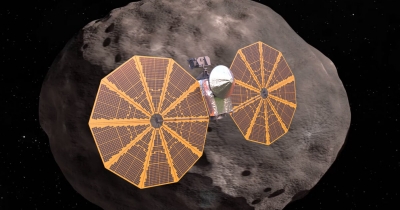
Since time immemorial, humans have looked at the skies for clues about their history. The Lucy probe, launched recently by NASA, too, like many other missions in the past, seeks to understand the origin of the solar system, the universe and our place within them. And it is focussing its exploration at a place where previous space missions have not been to-the trojan asteroids. What are they? How will the Lucy probe travel to these far-off territories?
What is the Lucy mission all about?
The Lucy mission was launched by the U.S. space agency NASA on October 16. It is the first spacecraft launched to explore the trojan asteroids, a population of primitive asteroids orbiting in tandem with Jupiter. The spacecraft will fly-by a total of eight different asteroids including a main belt asteroid and seven trojan asteroids. With the help of a suite of scientific instruments, Lucy will study the geology, composition, density and structure of each of its targets. The NASA is especially interested in finding primordial organic material on trojan asteroids because billions of years ago. this material may have seeded Earth with the chemical ingredients necessary for life thanks to asteroid impacts. Because asteroids, including trojan asteroids, are remnants from the birth of the Solar System, scientists believe the Lucy mission can uncover details of the early universe. The asteroid probe could also help scientists learn how our planets ended up in their current spots.
During its 12-year mission, Lucy will rely on two giant fan-like solar arrays, which will carry it farther from the sun than any solar-powered spacecraft has ever flown before. The solar panels will provide about 500 watts of power when the spacecraft is flying past the trojan asteroids. But Lucy also has fuel to help it execute some skilled manoeuvres on the way to the asteroids.
By the way, does the name Lucy’ ring a bell? Well, Lucy was the nickname of a famous human fossil from Africa, which taught us much about where our species came from. Likewise, the Lucy mission will revolutionise our knowledge of planetary origins and the formation of the solar system, says the NASA.
What is an asteroid?
Asteroids are space rocks that orbit the sun. They are too small to be called planets and hence are called minor planets. The solar system was born about 4.6 billion years ago, when a big cloud of gas and dust collapsed. When this happened, most of the material fell to the centre of the cloud and formed the sun. Asteroids are rocky leftovers from the formation of the solar system. They were formed from small pieces of rock and metal. Asteroids come in different shapes and sizes. They can be irregularly-shaped or near-spherical. They are often filled, with craters. The size could be as large as 530 km in diameter or as small as pebbles. The mass of all the asteroids combined is less than that of Earth’s moon, according to NASA. More than 150 asteroids are known to have a moon or two.
Where are the asteroids found?
Most of the asteroids are found orbiting the sun between Mars and Jupiter, which is the main asteroid belt.
The asteroids that orbit close to our planet are Near-Earth Asteroids (NEA). Over 20,000 near-earth asteroids are known to exist.
What are trojan asteroids?
- The Jupiter trojans, commonly called trojan asteroids, are a large swarm of asteroids that share the planet Jupiters orbit around the Sun. They do so in two loose groups – one group leads ahead of Jupiter in its path, the other trails behind.
- The term “Trojan Asteroid” specifically refers to the asteroids co-orbital with Jupiter, but the general term “trojan” is sometimes more generally applied to other small Solar System bodies with similar relationships to larger bodies: for example, there are both Mars trojans and Neptune trojans. Earth too has one trojan sharing orbit with it.
- Jupiter trojans are theorised to have formed in the same part of the Solar System as Jupiter and entered their orbits while it was forming.
- There are about 7,000 trojan asteroids, Even though they share an orbit with Jupiter, the asteroids are very distant from the planet itself- almost as far away as Jupiter is from the sun, according to the NASA.
How will the trajectory be for Lucy?
Over the course of its mission, Lucy will swing by Earth twice for gravity assists that can slingshot it on the right path. Lucy will reach its first target: a small asteroid, called Asteroid 52246 Donaldjohanson, in the main belt between Mars and Jupiter in 2025. The spacecraft will test its sensors here, before its main mission: flying by seven different trojan asteroids, ranging in size from a tiny moon to a large binary asteroid.
The probe is likely to visit the trojan asteroids in the following order and dates:
- Eurybates and Queta (moon) – August 2027
- Polymele – September 2027
- Leucus – April 2028
- Orus- November 2028
- Patroclus and Menoetius – March 2033
Once this mission ends, the team plans to propose an extended mission to explore more trojans. According to the NASA the trajectory can allow the probe to take further loops as long as the spacecraft is healthy.
What is special about the choice of these trojan asteroids?
Lucy will offer the first close-up view of all three major types of asteroids – the so-called C-, P- and D-types. The P and D-type trojans resemble the asteroids found in the Kuiper Belt that extends beyond the orbit of Neptune. The C-types are found mostly in the outer parts of the main belt of asteroids. All of the trojans are thought to be abundant in dark carbon compounds. Scientists believe that they are probably rich in water and other volatile substances.
Picture Credit : Google




